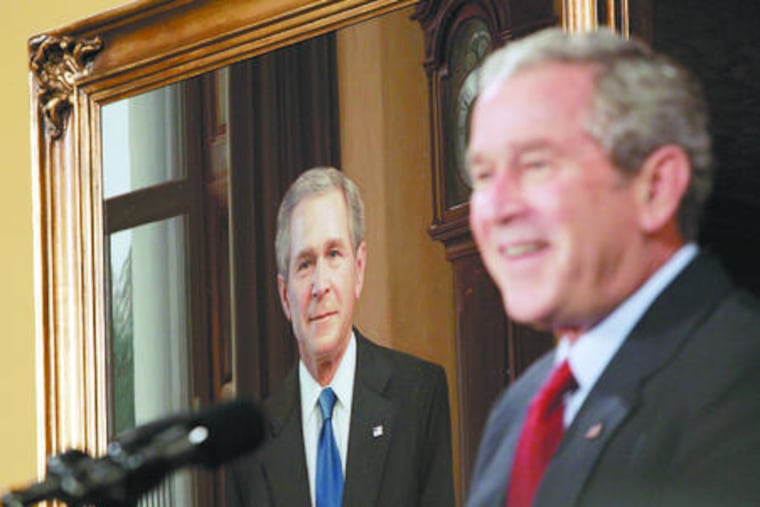Portrait artists are sitting pretty
Departing officials seek a brush with posterity.

WASHINGTON - Behind every great man or woman in Washington there is a great painting. As the Bush presidency closes, portrait artists can expect a surge in business from cabinet secretaries and other elite political appointees who want to preserve their legacies - and their images - for posterity.
The Commerce Department, for instance, recently requested artists' bids to paint a likeness of Secretary Carlos M. Gutierrez, who has served since early 2005. The contract pays up to $35,000, and Gutierrez gets to select the winning painter, said Rick Dubik, the department's director of administration.
The Coast Guard in August awarded a $12,000 contract for a portrait of Adm. Thad W. Allen, a sharp drop from the $23,500 it spent in 2005 for a likeness of Allen's predecessor as commandant, Adm. Thomas H. Collins.
"We have a very strong sense of history, and this is a critical part of it, having that formal tie to the past," said Coast Guard spokeswoman Angela Hirsch.
But investing taxpayer money in the time-honored art of official portraiture has become increasingly controversial. In a throwback to the Jimmy Carter era, some fiscal watchdogs and government scholars suggest that high-quality photographs would be a more cost-efficient way to honor departing dignitaries, especially because most portraits are largely inaccessible to the public.
The price of original portraiture ranges widely. In a sampling, the Washington Post examined summaries of 30 portrait contracts, most awarded with no competitive bidding, and found costs ranging from $7,500 to nearly $50,000. Officials say costs sometimes run higher.
At the upper end of the scale, the Defense Department awaits the expected February completion of a $46,790 portrait of controversial former Secretary Donald H. Rumsfeld. It will grace a Pentagon hallway lined with portraits of his predecessors, including one from Rumsfeld's first stint as defense secretary from 1975 to 1977, officials said.
"Thirty to $35,000, believe it or not, is actually cheap," said Dubik, who has overseen portrait commissions for several of the Commerce Department's 34 previous secretaries. "Most of the artists out there, if you look at some of them and what their charges are, it's basically anywhere from $50,000 to $75,000."
Ryan Alexander, president of Taxpayers for Common Sense, said agencies should consider snapping photographs of lesser-known officials. She questioned, for example, spending $19,000 for a portrait of former National Cancer Institute director Andrew C. von Eschenbach, now head of the Food and Drug Administration.
"I think most people like the tradition of presidents having their portraits painted," Alexander said. "But where does the line get drawn?"
Officials offer many rationales for spending to create original art, a tradition that has encompassed not only cabinet agencies but also the White House, Congress and Supreme Court.
Ellen G. Miles, curator of painting and sculpture at the National Portrait Gallery, said the museum was researching official portraits for a possible exhibit of such works in 2011. "It's an old tradition in Western art that goes back to the Renaissance. The idea is to honor and celebrate the person's accomplishments," Miles said.
President George Washington once sat for famed artist Gilbert Stuart, but in modern times lesser-known artists have dominated the world of government portraiture.
Joy Thomas of Murray, Ky., who has painted Collins, the former Coast Guard commandant, and former Navy Secretary Richard J. Danzig, said she typically needs six to eight months to complete a work. Some portraitists work from photographs, but she prefers painting from life, which requires up to 10 sittings of three hours each.
"The way a reputation is made is by doing official, archival portraits," said Thomas, 50, who said it was still "a mystery to me" how the contracts are awarded.
James Pollard, 54, of Cazenovia, Wis., has twice painted former Transportation Secretary Norman Y. Mineta - once to mark Mineta's tenure as chairman of the House Committee on Public Works and Transportation and the other in honor of his service as secretary of commerce in the Clinton administration. "You're sort of creating a historical artifact and the better it is, the nicer it is to have around in the future," he said.
Mineta said the public should have more opportunity to view these works because they can be inspirational. He said he sometimes lingered in a hallway lined with portraits to consider his predecessors' accomplishments.
"As I go down the hallway looking at these, I just sort of thank and salute these former secretaries for the job they did," Mineta said. "And, hopefully, as some future secretary is looking at my portrait, either in Transportation or Commerce, they might say, 'Hey, Norm, thanks for the job you did.' "